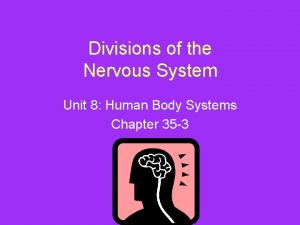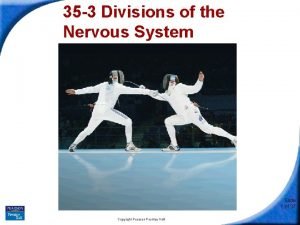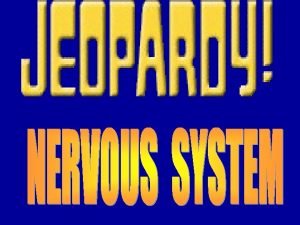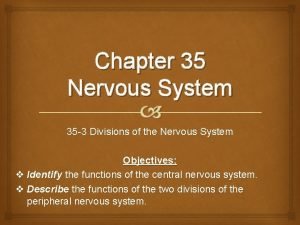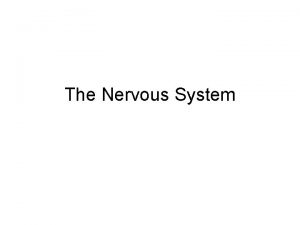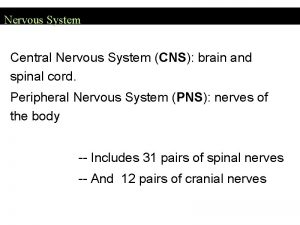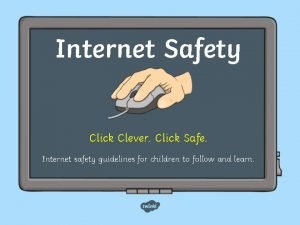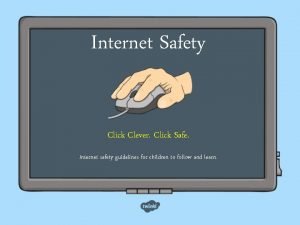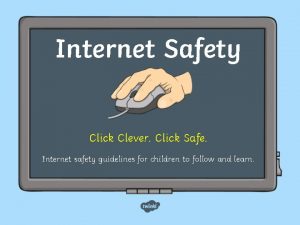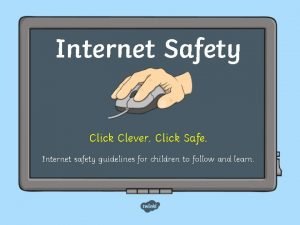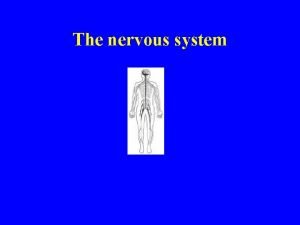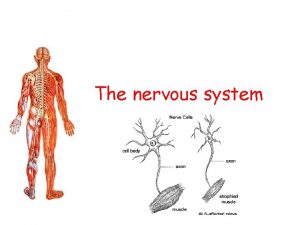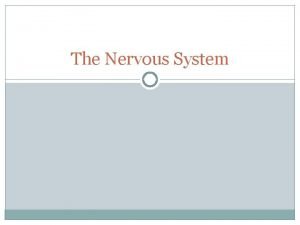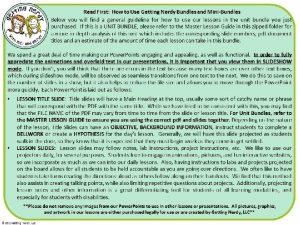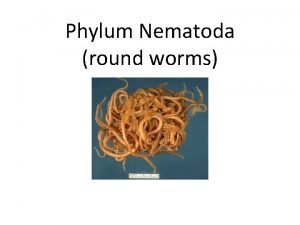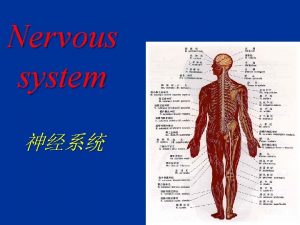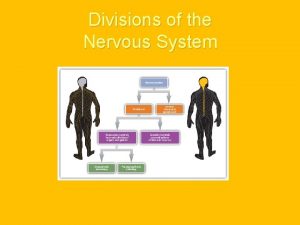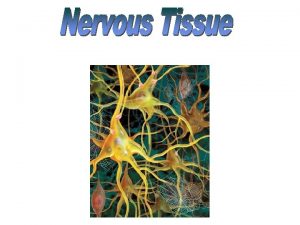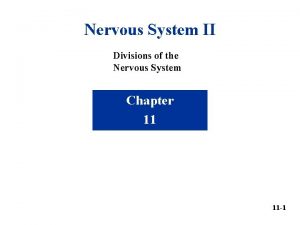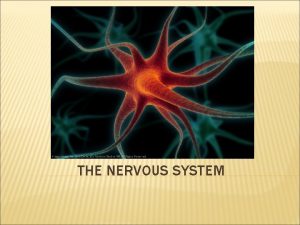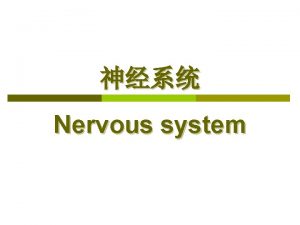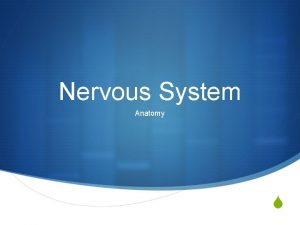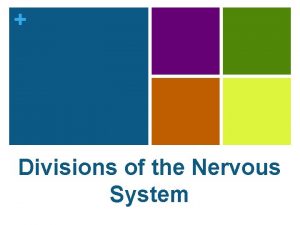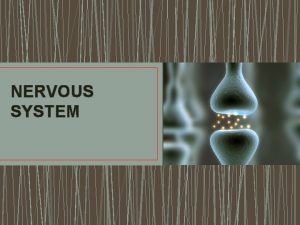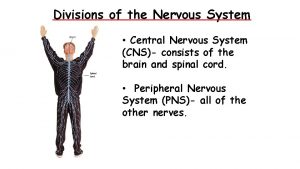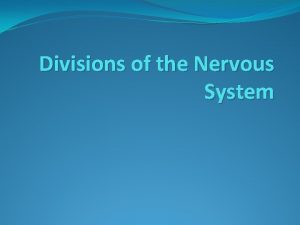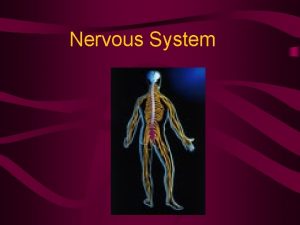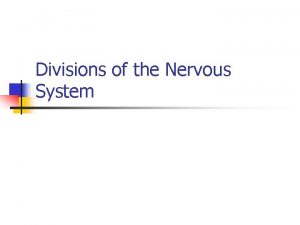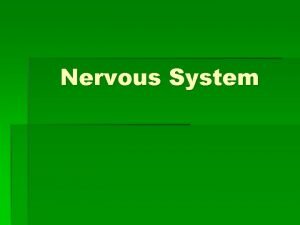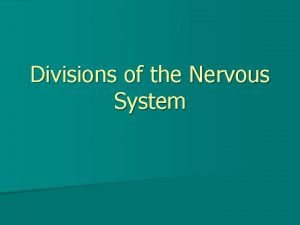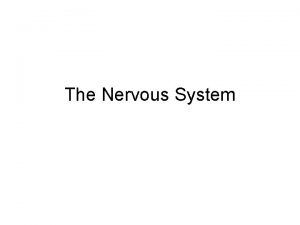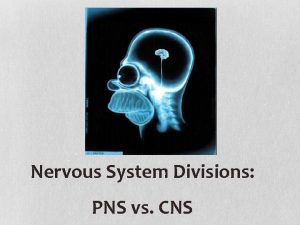Divisions of The Nervous System Click me Click



































- Slides: 35

Divisions of The Nervous System

Click me!




Click me!



Bases of Comparison Sympathetic Neurons Parasympathetic Neurons Effect Active body function “fight or flight” Normal activity “rest and digest” Neurotransmitter Noradrenalin Acetylcholine Restoring enzyme Monoamine oxidase Acetylcholinesterase SAME Function automatically (involuntary) Serve all internal organs

Fight or Flight Adrenal Glands Sudden simultaneous release of noradrenalin from all the sympathetic neurons (as in times of fright) has a critical effect.


It causes the release of the hormone adrenalin from the interior of the adrenal glands located on top of the kidneys. The noradrenalin and the adrenalin initiate and sustain what is known as the ‘Fight or Flight” response.

They prepare the body to respond to danger in the following ways: 1. Increase heart rate so that more blood is supplied to the body more quickly. 2. Widen air passageways so that more air can be exchanged with each breath.

3. Sudden contraction of some muscles to tense the body up for action. Included in this is the contraction of the diaphragm. A scared person will gasp, inhaling suddenly.

4. The iris of the eye contracts thus widening the pupil to maximize visual alertness. 5. Increased blood flow to the skeletal muscles so they are more able to act. 6. Decreased digestive activity, circulation and control.


If you need help to label/colour your brain … Try this … http: //www. youtube. com/watch? v=f. PIc. Q 640 Eo. E ALSO!! Seriously … SERIOUSLY, you should have worked your way through the simulations now. Especially the ‘outreach harvard’, ‘whfreeman’, ‘phet. colorado’ and ‘mcgraw-hill’ links at a MINIMUM!! They are fast, educational, interesting, cool, and even fun. No way that you can’t enjoy Mouse Party!

Brain: Medulla Oblongata -Brain Stem (bottom of the brain) -Pathway between brain and spinal cord -Controls: Vomiting, coughing, sneezing, hiccoughing, swallowing. -Controls: Heartbeat rate, breathing, and blood pressure.

Cerebellum -Butterfly shaped -Rear, lower portion of the brain -Second largest portion of the brain -Controls: Muscle co-ordination (smooth graceful motions) muscle tone, balance and posture.

Hypothalamus -Located just above the pituitary gland. -Controls: The pituitary gland production of hormones Hunger, thirst, sleep, body temp, water balance, and BP. Maintains homeostasis by controlling endocrine system

Thalamus -Above the hypothalamus -Controls: Relay station for information going to the cerebrum. Channels info to appropriate place and prevents sensory overload.


Cerebrum -Largest part of the brain -Controls: Conscious thought Perceives sensory information Initiates movements -Contains 2 hemispheres (Right and left) -Memory

Parts: 1. 2. 3. 4. Frontal Lobe- Conscious thought Parietal Lobe – Temperature, Touch and Pain Temporal Lobe – Hearing and smelling Occipital Lobe – Vision

Corpus Callosum -Holds the hemispheres of the Cerebrum together -Conducts impulses from one side of the brain to the other.

• Quick Review Questions C

D

B

A

B

B

D

D Hypothalamus would NOT make ADH (antidiuretic hormone) and would NOT send it to the posterior pituitary gland. ADH would NOT be released which would cause the collecting duct in the nephron in the kidneys to be relatively impermeable to water. The urine would be more dilute and less water would be taken back into the body.

What makes humans distinctive in animal world? • Is it the size of brain?

• Not really … (elephant and whales are larger) • Has to do with the size, increase in the folds of the cortex and the cortex’s ratio of the brain’s total weight. (i. e. In shrews, the cortex accounts for 20% of the brain's weight, and in humans, it accounts for 80%!) • The increased folds, enable a larger cortical surface area to fit inside the cranial vault, allow for a better organization of complex behaviours.
 8 divisions of the nervous system
8 divisions of the nervous system 35-3 divisions of the nervous system
35-3 divisions of the nervous system Divisions of the nervous system
Divisions of the nervous system Section 35-3 divisions of the nervous system
Section 35-3 divisions of the nervous system Nervous system divisions
Nervous system divisions Division of nervous system
Division of nervous system Slidetodoc
Slidetodoc Electrical synapse vs chemical synapse
Electrical synapse vs chemical synapse Label the parts of the main division of the nervous system
Label the parts of the main division of the nervous system Neuronal pools
Neuronal pools Sensory input and motor output
Sensory input and motor output Fundamentals of the nervous system and nervous tissue
Fundamentals of the nervous system and nervous tissue Clever click
Clever click Click clever click safe campaign
Click clever click safe campaign Click clever click safe
Click clever click safe Click clever click safe
Click clever click safe Nervous system and digestive system
Nervous system and digestive system Endocrine system vs nervous system
Endocrine system vs nervous system Amino acid-based hormones
Amino acid-based hormones Endocrine system
Endocrine system Chemical messengers of the nervous system
Chemical messengers of the nervous system Is flatworm asexual reproduction
Is flatworm asexual reproduction The nervous system is made up of
The nervous system is made up of Three basic functions of the nervous system
Three basic functions of the nervous system Learning objectives of nervous system
Learning objectives of nervous system Chapter 7 the nervous system
Chapter 7 the nervous system What is stimuli in nervous system
What is stimuli in nervous system Nervous system objectives
Nervous system objectives Craniosacral region
Craniosacral region Alpha 1 receptors
Alpha 1 receptors 31 nerves
31 nerves Sns pg
Sns pg Brain scienstructable
Brain scienstructable Autonomic nervous system pathway
Autonomic nervous system pathway Phylum
Phylum Arthropods respiratory system
Arthropods respiratory system
